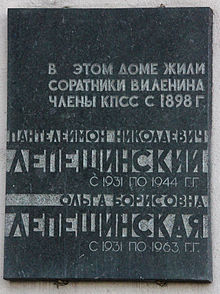Olga Borisovna Lepeschinskaya
Olga Borisovna Lepeshinskaya ( Russian Ольга Борисовна Лепешинская , scientific. Transliteration Ol'ga Borisovna Lepešinskaja ; August * 6 . Jul / 18th August 1871 greg. In Perm , † 2. October 1963 in Moscow ), born Protopopowa ( Russian Протопопова ), was a Russian Bolshevik , revolutionary and biologist. Their supporters included Stalin , Trofim Lysenko and Alexander Oparin . Among other things, she was a supporter of the theory of the spontaneous generation of cells from what she called “living matter”. Through the mediation of their supporters, this teaching was also adopted in textbooks and plans in the 1950s, both in the Soviet Union and in other socialist countries.
Life
Olga Protopopova was the daughter of a math teacher who died when Olga was three years old. As a result, she was raised by her mother, who was a successful entrepreneur. She owned steamships on the Kama and mines and factories in the Urals . Olga Protopopova went to St. Petersburg to take medical courses for women and joined the revolutionary movement there. In 1895 a group of revolutionaries around Lenin was imprisoned. One of the prisoners, her later husband Panteleimon Nikolajewitsch Lepeschinski (1868–1944), was looked after by her from then on. She followed him into exile in Siberia 1897–1900 and 1902–1903, where she further intensified her revolutionary activity and got to know Lenin personally. During the second exile, Olga helped her husband escape to Switzerland. In exile in Geneva , both became staunch Bolsheviks under Lenin's influence.
At the age of 45, Olga Lepeschinskaya graduated from the Higher Medical Courses for Women in Moscow. It was only after the October Revolution that she was able to conduct independent research, initially from 1920 in the histological laboratory of Moscow University, and since 1924 at the newly founded Timirjasew Institute for Natural Sciences and Propaganda of the Scientific Basis of Dialectical Materialism.
Act
Olga Lepeschinskaja resolved to refute Rudolf Virchow's thesis that cells always arise from cells. She extended Ernst Haeckel's basic biogenetic rule to cells and found alleged evidence that cells could arise from what she called “living matter”. While her daughter and son-in-law later actively supported her research, her husband was not convinced of the theories she had developed. A large number of Soviet biologists also found their methods and results to be questionable. In the 1950s, however, Olga Lepeschinskaja found prominent supporters, especially in Stalin and Lysenko . The latter hoped, among other things, for support for his theses on the transformation of species through their theory of "living matter".
When Lepeschinskaja announced that soda baths would have a rejuvenating effect, this briefly led to a shortage of soda. While this claim was quickly refuted, the “living matter” theory held up until her death. Daughter and son-in-law, who had meanwhile been dismissed by the director of the Institute for Experimental Medicine, made one last attempt in 1969 to rehabilitate the theory with a new publication. At that time, however, there were already numerous articles and books that criticized their results and methods.
supporting documents
- ↑ W. Safonow: From the life of a great biologist. Biographical sketch about Olga Lepeschinskaja. Publishing house culture and progress, Berlin 1954.
- ↑ a b c d Laris Shumeiko: The living matter and the transformation of species - The "new" cell theory by Olga Borisovna Lepešinskaja (1871–1963). In: Uwe Hoßfeld, Rainer Brömer (ed.): Darwinism and / as ideology (= negotiations on the history and theory of biology. Vol. 6). VWB - Verlag für Wissenschaft und Bildung, Berlin 2001, ISBN 3-86135-384-9 , pp. 213-228.
- ↑ a b Yakov Rapoport: The doctors' plot of 1953. Harvard University Press, Cambridge MA 1991, ISBN 0-674-21477-3 .
- ↑ Alexander Kitaigorodski: Magic, telepathy and all sorts of miracles. Dealing with pseudosciences (= nl specifically 36, ZDB -ID 49967-5 ). 2nd, revised edition. New Life Publishing House, Berlin 1979, pp. 88-107.
Web links
- Literature by and about Olga Borissowna Lepeschinskaja in the catalog of the German National Library
| personal data | |
|---|---|
| SURNAME | Lepeschinskaja, Olga Borisovna |
| ALTERNATIVE NAMES | Лепешинская, Ольга Борисовна (Russian spelling) |
| BRIEF DESCRIPTION | Russian biologist |
| DATE OF BIRTH | August 18, 1871 |
| PLACE OF BIRTH | Perm |
| DATE OF DEATH | 2nd October 1963 |
| Place of death | Moscow |
